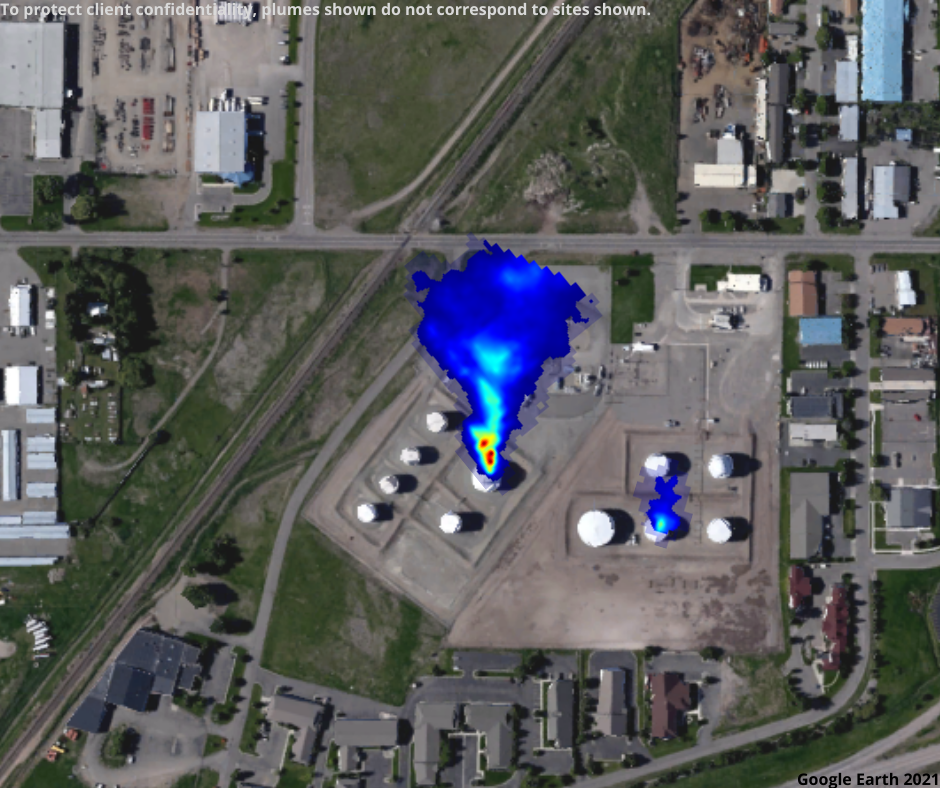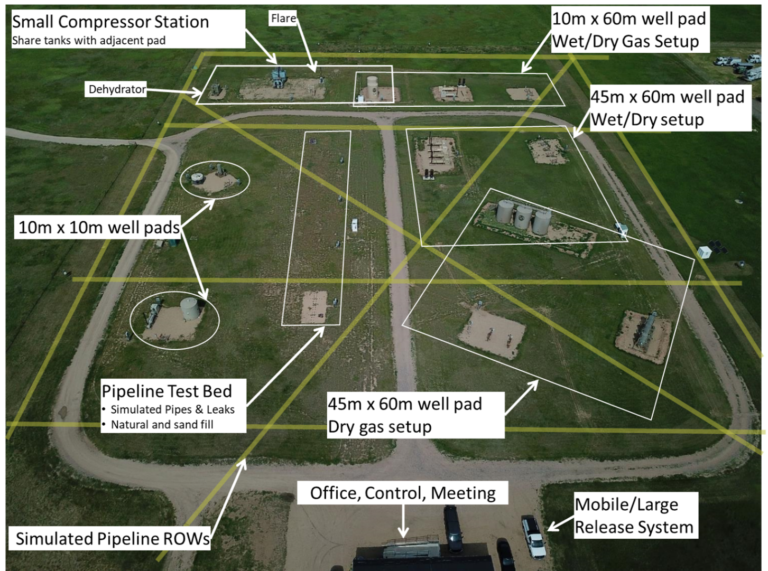How Photonics Will Help Curb Methane Emissions And Slow Global Warming

By Abby Proch, former editor
It seems carbon dioxide has been upstaged. For now, at least, the spotlight is squarely fixed on methane —a greenhouse gas that is 25 times more potent than CO2 at locking heat in the earth’s atmosphere and has more than doubled in concentration over the past 200 years. That’s raised concerns with the Biden administration, who a year ago called for a 30 percent reduction in overall methane emissions by 2030.
Now, the Environmental Protection Agency and the Department of Transportation are devising new rules to reduce methane emissions from new and existing oil and gas pipelines within each of their domains. The oil and gas industry is the largest industrial source of methane in the United States, responsible for producing about 30% of the country’s total methane emissions. By updating rules to further limit intentional venting and flaring and reduce unintentional distribution pipeline leaks, the EPA hopes to reduce most types of oil and gas emissions by about 75%.
But how, exactly?
Before emissions can be reduced, repairs must be made. And before repairs can be made, leaks must be identified. Methane emissions detection has come a long way since miners took chirpy yellow birds into the depths of the earth. Centuries later, innovation continues to predominate, with novel photonic technologies quickly gaining ground on existing methods.
To Fix Leaks, You First Have To Find Them
As it stands, the EPA has approved just two ways to detect and measure methane gas emissions: a flame ionization detector (FID) and an optical gas imaging (OGI) camera. With the former, crews use it, a GPS unit, anemometer, and supporting computer equipment to take samples. The FID identifies a leak when a sample and carrier gas travelling through a hydrogen-air flame creates a current sensed by an electrometer, according to ECS at the University of Massachusetts. The greater the current, the higher the amount of methane in the sample. They do not capture gas plume location or size.
However, OGI cameras do. According to a case study by Teledyne FLIR, who makes OGI cameras, an OGI camera indicates the approximate size of a leak and the direction its plume is heading. OGI cameras also allow inspectors to assess a system from afar, while FIDs require users to test up close and test often. OGI appears to dominate the scene of methane detection, but new-to-the-scene solutions are offering another, higher up approach.

Stepping Back To See Closer With Aerial Lidar Imaging
Methane gas detection typically involves some degree of closeness, whether that involves an inspector walking along a pipeline and using a handheld “wand” to detect emissions or using a camera tripod situated several feet feet from a target. Closeness often allows a certain level of accuracy, but it also carries a level of risk. Human exposure to harmful gasses run the gamut, with the worst involving an explosion. But in 2015, one photonics firm happened upon a way to do both — produce quantifiable results and offer a greater level of inspector safety.
Bridger Photonics didn’t set out to devise its Gas Mapping Lidar product, but an ARPA-E grant from the Department of Energy soon had them pursuing ways to use their core lidar product for methane detection. Four years and many rounds of testing later, the company debuted Gas Mapping Lidar — now it’s flagship product.
“From the scanned lidar data and aerial photos captured simultaneously, our processing and analytics create high resolution, geo-registered methane plume imagery and leak rate quantification. Effectively, we hand our clients a map with each leak location and emission rate precisely and accurately identified,” said Peter Roos, CEO of Bridger Photonics.
Gas Mapping Lidar operates via a fixed wing aircraft to survey oil and gas industry sites for both fugitive emissions (unintentional leaks) and process emissions (intentional emissions occurring during the process). It is reported to capture 3kg/hr of methane gas with greater than 90% probably of detection (POD) under typical conditions at a production site, according to Roos. The EPA has proposed a minimum sensitivity of 10kg/hour. However, GML and other alternative methods are not yet approved by the EPA. In fact, GML is the first of its kind to be submitted for approval. More on that later.
Bridger's GML grew 100% quarter over quarter in 2019 and outpaced the company's leading revenue stream in 2020. Roos doesn’t see it slowing down any time soon.
“Over the past five years, we’ve witnessed rapid increase in demand for emissions detection as environmental sustainability becomes an integral part of every energy company’s operational goals. Investors and shareholders are demanding sustainability from their portfolios to reduce climate change. So, operators in the oil and gas industry are making decisions based on environmental concerns as well as safety priorities,” said Roos.
However, Bridger Photonics isn’t alone in its pursuits. Scores of companies developing solutions are edging their way into a niche industry that continues to grow.

Tackling Emissions Takes A Village
Colorado State University's Methane Emissions Technology Evaluation Center (METEC) looks like the real deal — variously sized well pads, a compression station, and pipeline — but it’s not. Rather, it’s quite controlled and choreographed, much to the benefit of the solutions developers wanting to test their methane gas-detecting prototypes objectively and accurately. This is a testing site where solutions developers flock to test and hone their solutions.
Active since 2016, the Center has hosted over 40 developers and their solutions, from handheld point concentration sensors to manned aircraft conducting hyperspectral imaging to UAV-enabled line concentration sensors. METEC offers developers with fledgling solutions a custom and confidential approach to testing their detection method’s efficacy and also allows participation in its own public research programs.
While some promising solutions tested at METEC, including Bridger’s GML, use UAVs or aircraft to get a better look at methane emissions, on the horizon is an even more distant approach.
Seeing From Space
Next year, Carbon Mapper will being hunting down the world’s methane gas “super-emitters,” those select few leaks that account for the bulk of the world’s emissions. Carbon Mapper is projected to detect at least 80% of high emission methane and carbon dioxide sources through a “combination of sensitivity, moderate spatial coverage (high priority regions), and daily to weekly sampling provided by our constellation of multiple satellites.” Its supporting partner, NASA’s Jet Propulsion Laboratory, will provide an imaging spectrometer to break down light into hundreds of colors produce a spectral signature of molecules, such as methane and carbon dioxide. Emissions-detecting spectrometers on airplanes have surveyed methane emissions in California and the Southwest, but this earth-orbiting spectrometer with a 30-square-meter pixel size captures increasingly more detail.
For some time, little attention had been paid to methane emissions and the ways in which to curb it. Now that it’s apparent as the low-hanging fruit to reduce GHGs, a variety of detecting solutions are cropping up — and that’s a boon for both those solutions developers and for the environment. In an interview with Colorado Public Radio, METEC director Dan Zimmerle said the questions of how to detect methane leaks isn’t one-size-fits-all approach.
“The real answer, in the end, will be some hybrid,” said Zimmerle. “You could use something to find large leaks fast then small leaks eventually.” Aerial methane detection methods will help operators discover large leaks, while more hands-on approaches will deftly tackle smaller ones.
Simple Problem, Complex Solution
All signs point to more stringent emissions rules, but a final ruling on the new Clean Air Act rules isn’t expected until the end of 2022, according to the EPA. And although the newfound efforts to curb methane emissions aren’t yet written in stone, Bridger Photonics and others aren’t waiting for the final word. In fact, Bridger Photonics has not yet gained EPA approval for use of its GML as an official means of detecting methane emissions. But it is the first of its kind to try.
“I would say that this doesn’t impact the way we do business at all. We’re already providing a lot of value to the natural gas industry, and that value will only increase with approval of our technology to meet EPA requirements,” said Roos. One of its clients, an extension of ExxonMobil, did apply for approval EPA to use Gas Mapping Lidar, Bridger's proprietary solution, in March 2021. A result is expected within 12-18 months. While the approval wouldn’t give Bridger’s lidar solution a green light for all applications, it would allow other operators to piggyback on ExxonMobil’s approach in applying for their own approval.
What’s promising, both with the proposed rules and technological advancements, such as GML, is that a reduction in methane emissions is possible and can have quick effect. The pandemic has allowed scientists a sneak peek into what a few years’ worth of effort could yield. A report from NASA’s Jet Propulsion Laboratory found that the near-global shutdown in 2020 caused methane emissions to drop by as much as 10 percent. However, the concentration of methane in the Earth’s atmosphere did not decrease. Rather, it grew by 0.3%. According to the JPL report, a similar drop in nitrogen oxides (NOx), which can typically be considered a good thing, meant methane also had less hydroxyl radical to “scrub” it from the atmosphere.
What the EPA deems effective, how operators approach emissions reduction, even whether methane cutbacks can have an immediate diminishing on the environment — they’re all in flux. What is certain, is that if methane emissions continue at this rate (or greater), global warming will persist. If it’s curbed to the degree proposed, and especially with international involvement, the effects could be quick.
“Methane is short-lived but powerful. If you stop putting it in the atmosphere today, it will have a really big effect on temperatures even by mid-century,” said Matt Watson, the EDF’s Vice President of Energy, as quoted in a recent TIME article. Projected to decrease temperatures by 0.2 degrees C, the Biden initiative inches the globe just a bit closer to meeting the UN Climate Change Conference (COP 26) goal of a 1.5-degree reduction by 2050.
Works Cited
Baker, Aryn, and Data Reporting by Emily Barone. “COP26 Methane Pledge Is a Positive but Easy Commitment.” Time, Time, 3 Nov. 2021, https://time.com/6113196/cop26-methane-pledge/.
Biden, Joe. “Remarks by President Biden at an Event Highlighting the Progress of the Global Methane Pledge.” The White House, The United States Government, 2 Nov. 2021, https://www.whitehouse.gov/briefing-room/speeches-remarks/2021/11/02/remarks-by-president-biden-at-an-event-highlighting-the-progress-of-the-global-methane-pledge/.
Brasch, Sam. “The Federal Government Is Poised to Crack down on Methane from the Oil and Gas Industry. Can It Learn Anything from Colorado?” Colorado Public Radio, Colorado Public Radio, 1 Nov. 2021, https://www.cpr.org/2021/11/01/colorado-oil-and-gas-methane-emissions-testing/.
“Emission Reductions from Pandemic Had Unexpected Effects on Atmosphere.” NASA, NASA, 10 Nov. 2021, https://climate.nasa.gov/news/3129/emission-reductions-from-pandemic-had-unexpected-effects-on-atmosphere/.
“EPA’s Proposal to Reduce Climate- and Health-Harming...” U.S. Environmental Protection Agency, EPA, https://www.epa.gov/system/files/documents/2021-11/2021-oil-and-gas-proposal.-overview-fact-sheet.pdf.
“The Flame Ionization Detector.” College of Engineering, University of Massachusetts Amherst, https://www.ecs.umass.edu/eve/facilities/equipment/Agilent6890/The%20Flame%20Ionization%20Detector.pdf.
“Methane, CO2 Detection Satellite L Greenhouse Gas L Carbon Mapper.” Carbon Mapper, Carbon Mapper, 2 Nov. 2021, https://carbonmapper.org/.
“Using Optical Gas Imaging to Comply with OOOOA Regulations: A Case Study.” Teledyne FLIR, Teledyne FLIR, https://www.flir.com/discover/instruments/gas-detection/using-optical-gas-imaging-to-comply-with-ooooa-regulations-a-case-study/.
